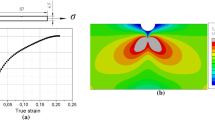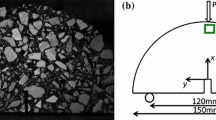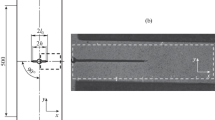Abstract
The fracture behavior of a crack propagating in a large (4.8 m × 1.4 m) aircraft panel was investigated quantitatively by experiment for the first time using digital image correlation. Mixed mode (I+II) stress intensity factors were evaluated using a methodology, which combined digital image correlation with the multi-point over-deterministic method to fit displacement field equations to the experimental data from around a crack tip. More than 800 images were taken during a 10-minute time period as the fracture of the panel occurred under monotonic loading. It was observed that the crack propagated through the skin of the panel at a relatively low speed, with an average crack tip velocity of 0.014 mm/s, and changed its propagation direction at particular points due to the reinforcement of the structure. In the later stages of the test, substantial shear lips were observed indicating a state of plane stress as would be expected in a thin, wide panel and the size of the plastic zone increased substantially. The value of the mode I stress intensity factor obtained from the measured displacement fields initially increased linearly to around 50 MPa√m (KIc = 37 MPa√m) and afterwards non-linearly reaching 300 to 400 MPa√m for crack extensions of the order of 100 mm. It is proposed that these high values of stress intensity factor do not represent an unrealistically high material fracture toughness but rather are indicative of the high resistance to crack growth of the structural assemblage of ribs, stringers and hole reinforcements in the panel which allow the skin to sustain a strain level that would otherwise cause unstable crack growth. Digital image correlation is demonstrated to be particularly powerful in elucidating this structural behavior.












Similar content being viewed by others
References
Sanford RJ (1989) Determining fracture parameters with full-field optical methods. Exptl Mech 29(3):241–247
Olden EJ, Patterson EA (2004) Optical analysis of crack tip stress fields: a comparative study. Fatigue Fract Eng Mater Struct 277:623–636
Dally JW, Riley WF (1991) Experimental Stress Analysis, 3rd edition, McGraw-Hill Inc
Chu TC, Ranson WF, Sutton MA, Peters WH (1985) Applications of digital-image correlation techniques to experimental mechanics. Exp Mech 25(3):232–244
Xu Z-H, Li X-D, Sutton MA, Li N (2008) Drift and spatial distortion elimination in atomic force microscopy images by digital image correlation technique. J Strain Anal 43(8):729–743
Jin H, Lu W-Y, Korellis J (2008) Microscale deformation measurement using the digital image correlation technique and scanning electron microscope imaging. J Strain Anal 43(8):719–728
Backman D, Liao M, Crichlow L, Yanishevsky M, Patterson EA (2008) The use of digital image correlation in a parametric study of the effect of edge distance and thickness on residual strains after hole expansion. J Strain Anal 43(8):781–789
Reu PL, Miller TJ (2008) The application of high-speed digital image correlation. J Strain Anal 43(8):673–688
Lopez-Crespo P, Shterenlikht A, Patterson EA, Withers PJ, Yates JR (2008) The stress intensity of mixed mode cracks determined by digital image correlation. J Strain Anal 43(8):769–780
Rethore J, Gravouil A, Morestin F, Combescure A (2005) Estimation of mixed-mode stress intensity factors using digital image correlation and an interaction integral I. J Fract 132:65–79
Yoneyama S, Morimoto Y, Takashi M (2006) Automatic evaluation of mixed-mode stress intensity factors utilizing digital image correlation. Strain 42:21–29
Muskhelishvili NI (1953) Some basic problems of the mathematical theory of elasticity. P.Noordhoff, Groningen
Q-400 introduction in 3-D correlation, DANTEC Dynamics
Ewalds HL, Wanhill RJH (1985) Fracture mechanics. Edward Arnold, London
Kanninen MF, Popelar CH (1985) Advanced fracture mechanics. Oxford University Press, New York
Nurse AD, Patterson EA (1993) Determination of predominantly mode II stress intensity factors from isochromatic data. Fatigue Fract Engng Mater Struct 16(12):1339–1354
Qian J, Fatemi A (1996) Mixed mode fatigue crack growth: a literature survey. Engng Fract Mech 55(6):969–990
Lopez-Crespo P, Burguete RL, Patterson EA, Shterenlikht A, Withers PJ, Yates JR (2008) Study of a crack at a fasten hole by digital image correlation, Experimental Mechanics, doi:10.1007/s11340-008-9161-1
Rosakis AJ, Ravi-Chandar K (1986) On crack tip stress state:an experimental evaluation of three-dimensional effects. Int J Solids Struct 22(2):121–134
Standard Test Method for Plane-Strain Fracture Toughness of Metallic Materials (1981) ASTM annual book of standards, Part 10, American Society for Testing of Materials. Philadelphia, E399-81, p588–618
Swift T (1987) Damage tolerance in pressurized fuselages, ICAF, Vol. 1, edited by D.L. Simpson, Paper 1, Engineering Materials Advisory Services, Ltd., Cradley Heath, England, U.K., June 1987
Feddersen CE (1971) Evaluation and prediction of the residual strength of center cracked tension panels, Damage Tolerance in Aircraft Structures, ASTM Special Technical Publication 486. American Society for Testing and Materials, Philadelphia, pp 59–78
Zhang X, Li Y (2005) Damage tolerance and fail safety of welded aircraft wing panels. AIAA J 43(7):1613–1623
Nesterenko GI, Nesterenko BG (2009) Ensuring structural damage tolerance of Russian aircraft. Int J Fract 31:1054–1061
Nesterenko BG (2002) Analytical-experimental study of damage tolerance of aircraft structures, International Council of Aeronautical Sciences, Paper 333.1, Aug. 2002
Swift T (2003) Fail-safe design requirements and features, regulatory requirements, AIAA Paper 2003-2783, July 2003
Wanhill RJH, Schra L, Hart WGJT (1992) Crack resistance, fracture toughness and instability in damage-tolerant aluminium alloys, in Cyclic deformation, fracture and nondestructive evaluation of advanced materials. Mitchell MR, Buck O (eds) ASTM, STP 1157, p.224–241
Gu I (1992) An engineering approach for crack growth analysis of 2024-T351 aluminium alloy, fracture mechanics: Twenty-Second Symposium (Volume II), ASTM STP 1131, Atluri SN, Newman JC Jr, Raju IS, Epstein JS (eds.) American Society for Testing and Materials, Philadephia, p.246–256
Sumpter JDG (1999) An alternative view of R curve testing. Engng Fract Mechs 64:161–176
Collins RA, Cartwright DJ (1996) On the development of the strip yield model for the assessment of multiple site damage. Theor Appl Fract Mech 25:167–178
Aircraft Accident Report—Aloha Airlines, Flight 243, Boeing 737-200, N73711, near Maui, Hawaii, April, 1988/ Report no. NTSB/AA-89/03, National Transportation Safety Board, Washington, D.C., June 1989
Acknowledgement
The authors would like to acknowledge a number of detailed technical discussions with Professor Neil James of the University of Plymouth. The authors are extremely grateful for his thoughtful and insightful comments which have helped to guide their interpretation to the results.
Author information
Authors and Affiliations
Corresponding author
Rights and permissions
About this article
Cite this article
Du, Y., Díaz, F.A., Burguete, R.L. et al. Evaluation Using Digital Image Correlation of Stress Intensity Factors in an Aerospace Panel. Exp Mech 51, 45–57 (2011). https://doi.org/10.1007/s11340-010-9335-5
Received:
Accepted:
Published:
Issue Date:
DOI: https://doi.org/10.1007/s11340-010-9335-5




